7/15/2010
Spring Trials Part 2: The Cutting World
Chris Beytes
Despite some talk that today’s floriculture industry is more about marketing and positioning than it is about genetics, the No. 1 most-asked question in this industry is still “what’s new?” Thankfully, that’s what the California Spring Trials are all about. Held April 10-16, the Trials encompassed 17 stops and more than 40 participating companies, and every one of them had something new to share.
In July, we covered the “memorable” introductions (those that stuck in attendees’ minds even after viewing hundreds of ho-hum me-toos), along with highlights in seed-bred varieties. This month, we look at vegetative highlights, plus some of the fun marketing ideas we found.
Anyone can introduce a color addition or two. We enjoy discovering full series. Here are a baker’s dozen plus one:
An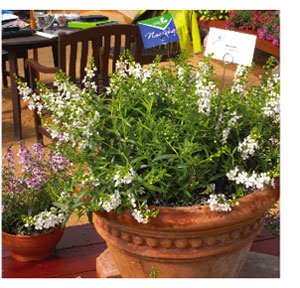 gelonia Actors series (Green Fuse Botanicals).
gelonia Actors series (Green Fuse Botanicals). This new series is a spreading/upright type that will fill out a mixed container or garden bed without getting floppy. Starts with White, Rose and Pink.
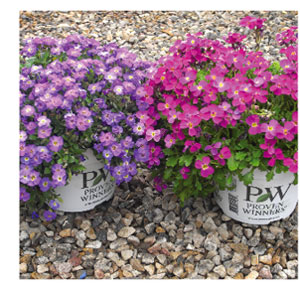 Aubrietia Madly series (Proven Winners).
Aubrietia Madly series (Proven Winners). This Zone 3 perennial is an early spring bloomer that grows 4-6 in. tall. Two colors: Madly Blue Violet, Madly Magenta.
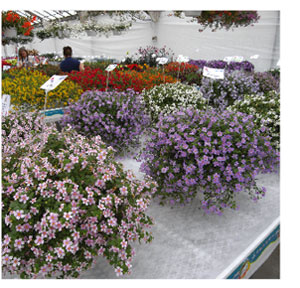 Bacopa Secrets XXL (Cohen).
Bacopa Secrets XXL (Cohen). You can tell from the name what this subseries of bacopa Secrets is all about (extra, extra large). Four colors: Central Pink, Blue Delight, White and Silver Sky.
 Begonia Beaucoup series (Green Fuse Botanicals).
Begonia Beaucoup series (Green Fuse Botanicals). Green Fuse’s new begonia series is a Boliviensis type (meaning semi-tuberous), but an interspecific hybrid. It’s said to be early and floriferous. Comes in White, Rose and Red.

Begonia Dragone series (Dümmen). This camellia-flowered heimalis begonias has big double flowers atop dark foliage. Said to be two weeks faster to flower than competing varieties. White Blush, Champagne, Sunset (pictured), Pink Hope.
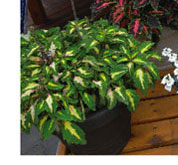 Coleus Mosaik series (Syngenta).
Coleus Mosaik series (Syngenta). The first coleus series for Syngenta, this four-color series was bred by Goldsmith.
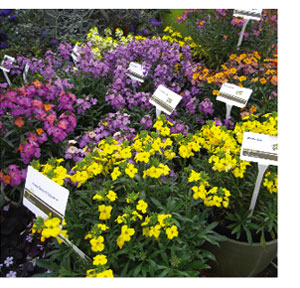
Erysimum Rysi (Plug Connection). Call it by the common name, wallflower. It’s an early-blooming tender perennial (Zones 7-8) that comes in four pretty colors. You grow it like a regal geranium: start in summer, bulk it up, then chill it.
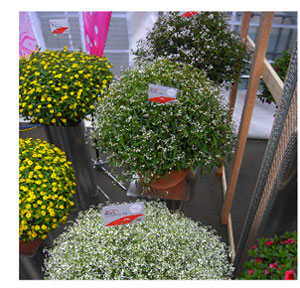
Euphorbia StarDust series (Dümmen). The StarDust series gets three introductions: Pink Shimmer (center) has an open habit that’s good for combos. Pink Glitter (back) is compact with pinkish bracts and darker foliage. And White Sparkle (foreground) is most compact and floriferous. Definitely a stand-alone—it’s too dense to act like baby’s breath in a combo.
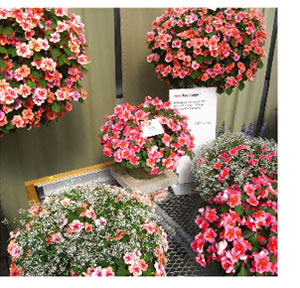
Impatiens Patchwork series (Ball FloraPlant). Patchwork is noted for its “wow!” colors, they say. It’s a walleriana type, so it’s easy to grow. The series starts with Peach Prism and Pink Shades.
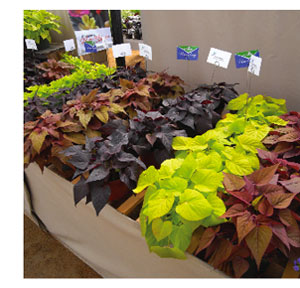
Ipomoea Sweet Georgia series (Green Fuse Botanicals). This new series replaces Sweet Caroline, which went to Proven Winners. The six colors have a mounded habit that’s well matched to one another.
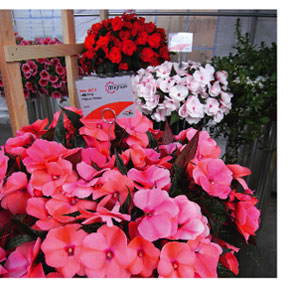 New Guinea impatiens Magnum series (Dümmen).
New Guinea impatiens Magnum series (Dümmen). To get in the market with a new New Guinea, you need big flowers, and Magnum looks to have them. Starts with six colors: Lavender, Salmon, White Blush, Fire, Peach
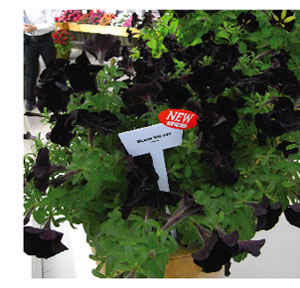
and Blue.
Petunia Black Velvet (Ball FloraPlant). One of the most-talked-about plants at this year’s trials, Black Velvet has two sister varieties: Phantom (black and yellow) and Pinstripe (purple and yellow). Black Velvet flowers early (under 10 1/2 hours of daylength).
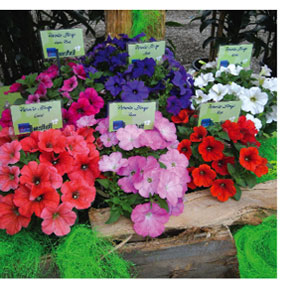 Petunia Perfectunia series (Westflowers).
Petunia Perfectunia series (Westflowers). Called Bingo in Germany, this vegetative petunia is compact and mounding. Starts with seven colors.
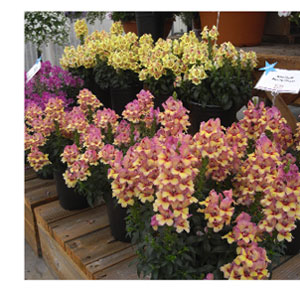 Snapdragon Dragon series (Ecke).
Snapdragon Dragon series (Ecke). It’s been a while since we saw a vegetative snapdragon series. Ecke’s is an upright type, with open-faced flowers. More heat tolerant than seed types, it’s good as an upright “thriller” in combos. Three colors: Buttery Dragon, Peachy Dragon and Rosey Dragon.
Earlier, it maybe have sounded like we were knocking color additions. Actually, they’re the lifeblood of the industry. And they’re easy additional sales! As for stand-alones, well, everyone seeks unique.
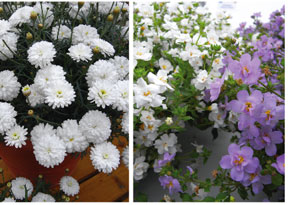 Argyranthemum Sassy Compact Yellow, Compact Double White (Syngenta).
Argyranthemum Sassy Compact Yellow, Compact Double White (Syngenta). Two excellent new argyranthemums with tidy habits. They join Compact Rose/White and Compact White. (That’s Double White pictured).
Bacopa Scopia colors (Dangizer). Danziger offers six new bacopa introductions: three in the large-flowered Scopia Gulliver line; and three Scopia Doubles—White, Pink Pearl and Blue (Double White and Double Blue pictured)
 Begonia Sherbet Bon Bon (Ball).
Begonia Sherbet Bon Bon (Ball). This pretty little begonia sports unique double yellow blooms. It’s more upright and less vigorous than Million Kisses.
Calla lily Night Cap (Golden State Bulb Company). One of seven new ones we were shown, Night Cap is a nice dark purple.
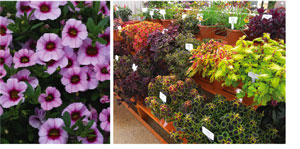 Calibrachoa MiniFamous colors (Selecta).
Calibrachoa MiniFamous colors (Selecta). This leading calibrachoa series gets even more colors: MiniFamous Compact Purple, MiniFamous iGeneration Light Pink + Eye (pictured) and iGeneration Gold Red Eye (iGeneration subseries features the “latest and greatest” large-flowered varieties).
Coleus introductions (GroLink). Does anyone offer more? We don’t think so. And GroLink added a bunch of new intros, including Red Hot Rio, Fancy Rose, Garnet Robe, Gnash Rambler, Inky Fingers … you get the idea.
Dianthus Kahori (Fides). Kahori is Japanese for “fragrance.” Very floriferous in the garden, they say; you can “whack it back with a lawnmower” and it will bloom all summer.
Leucanthemum Daisy M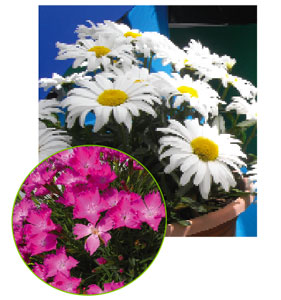 ay (Proven Winners).
ay (Proven Winners). This shasta daisy needs less vernalization than Broadway Lights. Hardy to Zone 5. It’s a limited release, so order early
Mandevilla Sun Parasol color additions (Suntory). Suntory put mandevilla on the national map with the introduction of the Sun Parasol line, which gets three new colors: Burgundy, Lush Crimson and White. All three are guaranteed add-on sales.
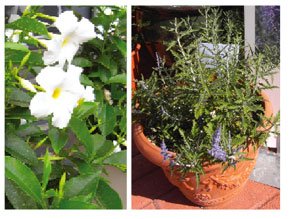 Perovskia Lacey Blue (Ball Ornamentals).
Perovskia Lacey Blue (Ball Ornamentals). Ball’s woody division offers this dwarf Russian sage, which they say is about 60% more compact than competing cultivars. It grows to 30 in. or so.
Petunia Pink Lemonade (Dümmen). YOU named this one … well, a Spring Trials attendee did. Dummen took name suggestions for this pretty new petunia, and Pink
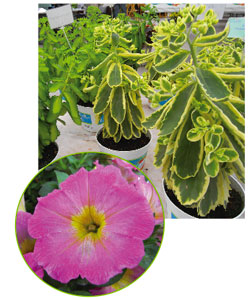
Lemonade was the choice. A striking stand-alone color.
Sedum Autumn Charm, Autumn Delight (Hishtil). Sedum is one of the easiest, toughest landscape perennials, and these two variegated forms are sports of the well-known Autumn Joy.
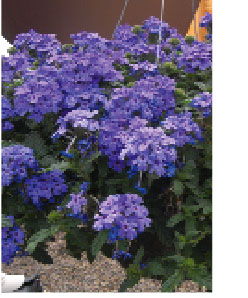 Verbena Superbena Royale Chambray (Proven Winners).
Verbena Superbena Royale Chambray (Proven Winners). An excellent blue addition to the Superbena family. Early and compact, it’s good for small pots at retail, but will still spread 12 to 24 in. for consumers.
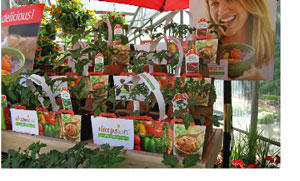 John Henry
John Henry showed an interesting herb and veggie partnership with the website
allrecipes.com. POP includes recipes, of course, along with attractive signage with taglines that read “All Fresh, All Delicious, All You.” It’s the most interesting partnership idea we’ve seen since Michells and The Weather Channel.
MasterTag’s research has found that 62% of gardeners want to keep plant tags for reference, while 66% want to use the tag in the garden. And anytime something adds up to more than 100%, you’ve got an opportunity. MasterTag has launched a unique two-piece “Snap Tag” with a stake portion for the garden and the remaining informational piece for your files.
 Burpee Home Gardens
Burpee Home Gardens had a successful first season. For its second year, you can offer finished sizes in the “Burpee Home Gardens To Go” line. This is larger conta
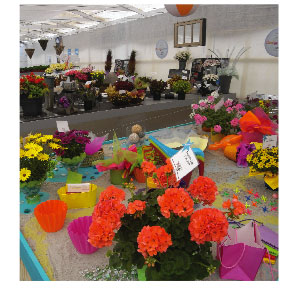
iners of finished or mixed herbs and veggies, such as fruiting tomatoes and bowls of salad greens and herbs.
At their new Design Center,
Ecke tracks hot fashion and decor trends and helps customers use them in their plant offerings. They used their Spring Trial to show off three trends: “Live” (natural materials), “Work” (metals, black, white, silver), and “Play” (bright, fun colors and patterns).
Prov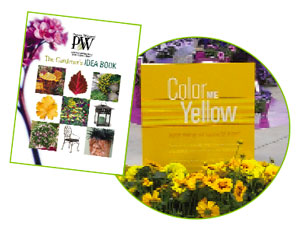 en Winners
en Winners showed a LOAD of marketing opportunities and assistance for growers and retailers, including reward points; Roadshows; Pop, Drop & Grow; their custom soils and fertilizers; the Gardeners’ Idea Book; and tons of advertising on television, radio and print targeting both casual and serious gardeners. Whew! They do a lot.
Keeping it simple but significant,
Syngenta’s color wheel display reminds us that color is probably the No. 1 reason the average consumer chooses a particular plant.
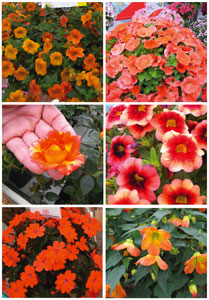
It’s fitting, with Holland making the World Cup finals, that orange seemed to be a trendy color at this year’s trials. It was prevalent in seed (marigold Moonsong Deep Orange, vinca Cobra Orange, geranium Horizon Tangerine, zinnia Double Zahara Fire) and we found it in vegetative intros as well:
Calibrachoa Callie Golden Sunrise (Syngenta)
Petunia Potunia Papaya (Dümmen)
Mini Rose Boogie Woogie (Greehheart)
Calibrachoa Coralberry Punch (Proven Winners)
Impatiens Sunpatiens Spreading Corona (Ecke)
Abutilon Lucky Lantern Orange (PlantHaven)
Some things don’t fit neatly into any one classification, but are still worth a mention. Here are a few:
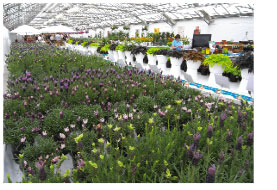 Pacific Plug & Liner
Pacific Plug & Liner offered a comparison trial of 50 different lavender varieties and 30 different sweet potato vines! You won’t find that anyplace else.
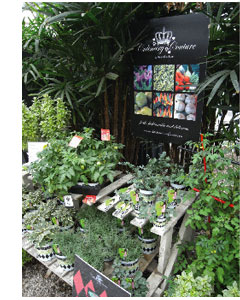 Hort Couture
Hort Couture is a brand built around a great name and a classy look. They’re accumulating some interesting genetics, and now they’re onboard the edibles trend with their
“Culinary Couture” line, which features heirloom veggies and fancy herbs.
It’s mum time, folks, and both
GroLink and
Syngenta showed off new Belgian mums and Yoder mums (respectively). GroLink has 14 new Belgians for this year and 15 more coming in 2011. Their focus is earliness, as well as developing full series. Yoder continues to refine and improve their garden mums, adding new and interesting colors to existing lines like Ursula. Pictured: Mouria Yellow from GroLink; Jazzy Ursula and Fancy Ursula from Syngenta.
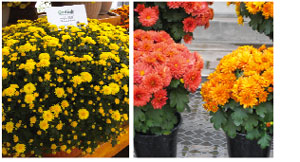
POP done WITH plants.
Plug Connection has developed a way to make signage out of seedlings. They plant seeds on some sort of top-secret substrate that’s attached behind a logo cut out in a sheet of plywood or foam board. The seedlings sprout, then they hit them hard w

ith PGRs to create a dense, living logo. They made a large one for the Los Angeles Auto Show. They say it lasts five days or so indoors.
GT
Check out our 40-plus Spring Trials videos at
www.youtube.com/growertalks or at the ANLA Knowledge Center. Special thanks to our ANLA partners for helping make these videos happen. They’ve had more than 12,000 views!